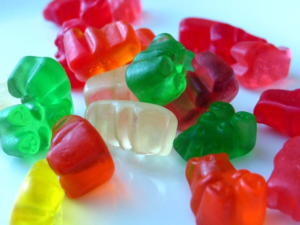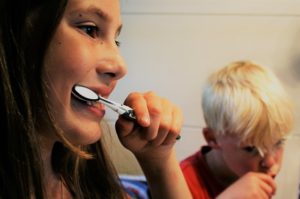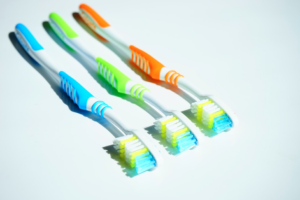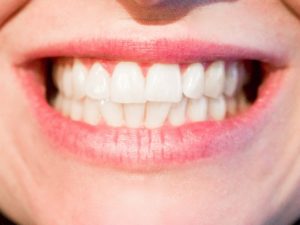Dentist in Pelham
 Multivitamins are an excellent way to help children and adults receive nutrients that their diet lacks. For parents of picky eaters, this can be especially helpful. However, not all vitamins are created equally. Chewable, gummy vitamins are often marketed to children but carry risks to your child’s oral health. Here are three ways gummy vitamins affect your child’s oral health.
Multivitamins are an excellent way to help children and adults receive nutrients that their diet lacks. For parents of picky eaters, this can be especially helpful. However, not all vitamins are created equally. Chewable, gummy vitamins are often marketed to children but carry risks to your child’s oral health. Here are three ways gummy vitamins affect your child’s oral health.
- Gummy Vitamins Stick to Your Child’s Teeth
Like gummy candy, particles of gummy vitamins can easily stick to your child’s teeth. Bacteria that causes decay feeds on sugars and food matters left on your teeth. Because they can be harder to clean by brushing, the risk of developing decay increases. If your child takes a gummy multivitamin, encourage them to brush their teeth thoroughly shortly after consuming one. Our dentist also suggests scheduling your child’s next visit to ensure a professional and thorough cleaning.
- Gummy Vitamins Contain Sugar
Compared to pills and harder, chewable multivitamins, gummy vitamins generally contain more sugar. Ingredients such as gelatin and sucrose are often found in gummy vitamins. Sugar feeds bacteria that can contribute to tooth decay.
- Don’t Confuse Them For Candy
Candy contributes to tooth decay because the sticky, sweet, sugary contents cling to teeth, promoting decay. Gummy vitamins are similar because they share several key ingredients with gummy candies. It is vitally important that your child never confuses a multivitamin for a candy. Consuming more vitamins than the suggested amount can lead to serious health complications.
Multivitamins can help balance a diet that does not include key nutrients. While gummy vitamins are often a great way for children to be excited to take a vitamin, consider the risks they pose to your child’s oral health. If your child does regularly take a gummy multivitamin, have them brush their teeth after taking one. Taking a vitamin before brushing your teeth prior to bedtime is one way to ensure your child’s teeth remain clean.
We advise you to consult your child’s pediatrician for information regarding which multivitamin supplements are best for your child. Children should receive at least two dental examinations per year, with additional visits needed for those with a high risk of developing decay or other oral health complications.
Contact our office to schedule your child’s next visit today.
6496 Quail Run Drive
Pelham, AL 35124

 Little teeth will grow into a big smile. To ensure your child is on track for a lifetime of optimal oral health, it is important to instill good oral hygiene habits early in life. We understand that this can sometimes be a challenge. It’s hard to keep the interest of young children, which can make brushing twice a day for two minutes each time difficult to do. We’ve gathered a few pointers to help you and your child make brushing time a fun experience.
Little teeth will grow into a big smile. To ensure your child is on track for a lifetime of optimal oral health, it is important to instill good oral hygiene habits early in life. We understand that this can sometimes be a challenge. It’s hard to keep the interest of young children, which can make brushing twice a day for two minutes each time difficult to do. We’ve gathered a few pointers to help you and your child make brushing time a fun experience. Do you ever think about your toothbrush? You use it twice a day, but how much do you know about it? We’ve compiled a list of interesting toothbrush facts. The next time you brush, consider these bits of trivia.
Do you ever think about your toothbrush? You use it twice a day, but how much do you know about it? We’ve compiled a list of interesting toothbrush facts. The next time you brush, consider these bits of trivia. When it comes to your child’s health and well-being, you want to be sure they are receiving the best possible care. Studies have shown that oral health is linked to overall health. It is important to have an experienced team that can work with your child to ensure a lifetime of optimal oral health. There are numerous advantages to choosing a pediatric dentist for your child including specialized training, a compassionate standard of care, and a welcoming environment.
When it comes to your child’s health and well-being, you want to be sure they are receiving the best possible care. Studies have shown that oral health is linked to overall health. It is important to have an experienced team that can work with your child to ensure a lifetime of optimal oral health. There are numerous advantages to choosing a pediatric dentist for your child including specialized training, a compassionate standard of care, and a welcoming environment. Proper dental hygiene is key to decreasing risk of periodontal (gum) disease in children. Hormonal changes in the body as your child grows increase blood circulation to the gums and may increase your child’s gum sensitivity. This can lead to a greater reaction to irritation, causing gums to become swollen and tender.
Proper dental hygiene is key to decreasing risk of periodontal (gum) disease in children. Hormonal changes in the body as your child grows increase blood circulation to the gums and may increase your child’s gum sensitivity. This can lead to a greater reaction to irritation, causing gums to become swollen and tender. Are you a diligent brusher who grabs the toothbrush as soon as you finish each snack or meal? While there are significant benefits to regular brushing, hurrying your hygiene might be doing more harm than good. The key lies in understanding the effects different types of food and drinks have on your teeth.
Are you a diligent brusher who grabs the toothbrush as soon as you finish each snack or meal? While there are significant benefits to regular brushing, hurrying your hygiene might be doing more harm than good. The key lies in understanding the effects different types of food and drinks have on your teeth. Loose teeth, bad breath, and painful, bloody gums – these are among the signs and symptoms of periodontal, or gum, disease. Unfortunately, periodontal disease can also begin without any obvious symptoms. If left undiagnosed or untreated, you could be at risk for irreparable damage to your teeth and gums. The good news is that periodontal disease is preventable. In fact, one of the most effective tools for preventing the disease only takes a minute of your time each day.
Loose teeth, bad breath, and painful, bloody gums – these are among the signs and symptoms of periodontal, or gum, disease. Unfortunately, periodontal disease can also begin without any obvious symptoms. If left undiagnosed or untreated, you could be at risk for irreparable damage to your teeth and gums. The good news is that periodontal disease is preventable. In fact, one of the most effective tools for preventing the disease only takes a minute of your time each day. Your child’s mouth contains hundreds of bacteria. Before your child reaches for the toothbrush and mouthwash, understand that not all bacteria are bad. Here’s what you need to know about the bacteria that makes its home in your child’s mouth.
Your child’s mouth contains hundreds of bacteria. Before your child reaches for the toothbrush and mouthwash, understand that not all bacteria are bad. Here’s what you need to know about the bacteria that makes its home in your child’s mouth. Teething is a natural and necessary part of your child’s growth. However, knowing that doesn’t make it any easier to handle. If your baby has started teething, or if you are trying to prepare for the onset of this stage, review the information below. Consult your child’s dentist for more information about your child’s specific needs.
Teething is a natural and necessary part of your child’s growth. However, knowing that doesn’t make it any easier to handle. If your baby has started teething, or if you are trying to prepare for the onset of this stage, review the information below. Consult your child’s dentist for more information about your child’s specific needs. Hoover Dentist
Hoover Dentist





